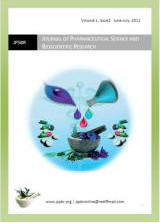





ISSN 2277 - 3681
Volume 2, Issue 2
Pages no. 40 - 96
Available online 13 April 2012
Bring your pointer on Abstract to show abstracts

A Review on: Antituberculosis Agents
Hemant K. Khairnar*, Rajesh J. Oswal, Rishikesh V. Antre








Diabetes Mellitus A Silent Killer: Role of DPP4 Inhibitors in Treatment
V. Jakhmola*, P. Tangri




Absorption Correction Method for Simultaneous Estimation of Metoprolol Succinate and Olmesartan Medoxomil
in Combined Tablet Dosage Form
B. N. Vora*, R. R. Parmar, D. A. Shah, P.P. Nayak




Development and Validation of First Order Derivative Spectrophotometric Method for Simultaneous Estimation of
Cefepime Hydrochloride and Amikacin Sulphate in Injection
Dave Vimal M*, Hirpara Kinjal P, Dr. Shital Faldu




The Simultaneous Estimation of Paracetamol and Tolperisone Hydrochloride in Tablet by UV Spectrophotometric
Methods
M. G. Patel*, R. R. Parmar , P. P. Nayak and D. A. Shah




Formulation and Optimization of Lamotrigin Fast Dissolving Tablet
Sachin S. Gupta*, Hitesh Patel, B.G.Prajapati, Shreeraj Shah




Development and Validation of HPTLC Method for Estimation of Tenofovir Disoproxil Fumarate in Tablet Dosage
Form
Mardia R. B.*, Suhagia B. N., Pasha T. Y., Chauhan S. P. and Solanki S. D.




Formulation and Evaluation of Controlled Porosity Osmotic Drug Delivery System of Carvedilol Phosphate
Hardik Patel*, M. M. Patel




Q-Absorbance Ratio Spectrophotometric Method for the Simultaneous Estimation of Cinnarizine and
Dimenhydrinate in their Combined Dosage Form
Pinal B. Shah*, Paresh U. Patel








Area Under the Curve Spectrophotometric Method for Determination of Tigecycline in Pharmaceutical Formulation
Aparna B. Chauhan*, Dipti B. Patel
First Derivative Spectrophotometric Method for the Simultaneous Estimation of Tolperisone and Paracetamol in
their Combined Dosage Form
Kavita K. Sharma*, Paresh U. Patel


© JPSBR Publications 2011-2024
Powered by Opus
ABSTRACT:
Tuberculosis is today amongst the worldwide health threats. In present study we reported current antituberculosis
regimen and compounds under clinical trials, compounds under clinical trials, mechanisms of action of
antituberculosis drugs or Antimycobacterials, effects of tuberculosis on pregnancy, first-line drug, second- line
drugs, anti-tuberculosis drugs related hepatotoxicity, tuberculosis small intestine, tuberculosis lymphadenitis,
multi-drug resistant and extensively drug resistant TB in India, prevention of MDR-TB and XDR-TB, diagnosis of
MDR-TB, Current status in the development of the new anti-tuberculosis drugs. In future our review will helpful for
researcher to find out novel antitubercular drugs.
KEYWORDS:
Antituberculosis, First-line drugs, Second-line drugs.
ABSTRACT:
Diabetes mellitus is rapidly becoming the world’s largest silent killer. World Health Organization says that in 2000,
approx 2.8% of the world population was suffering from diabetes (~180 million people), and estimate will be
almost double, by the year 2030. Treatment should aim to normalizing the basic defects in the disease, which are
islet dysfunction in combination with insulin resistance and should also, directly or indirectly target the diabetes
induced complications. Conventional treatments have been the use of Antidiabetic drugs like sulphonylureas and
Biguanides. , a new class of antidiabetic drug DPP4 inhibitors (vildagliptin, sitagliptin & saxagliptin etc.) targeted to
extrapancreattic cells. DPP-IV inactivates incretin hormone. There are two incretins, known as glucose- dependent
insulinotropic peptide (GIP) and glucagon-like peptide-1 (GLP-1), which share many common actions in the
pancreas but have distinct actions outside of the pancreas. DPP-4 inhibitors are a new class of agents that improve
long-term, 24-hour control of HbA1c, FPG (before meal) levels, and PPG (after meal) levels through decreased DPP-
4–mediated degradation of incretin hormones. DPP-4 inhibitors provide a complementary mechanism of action to
existing OADs and demonstrate significant efficacy when added to MET, an SU, or a TZD, with a well-tolerated
profile, including a low risk for hypoglycemia and weight neutrality.
KEY WORDS:
diabetes mellitus, DPP4 inhibitors, type II, glucose metabolism
ABSTRACT:
A new, simple, precise, accurate and sensitive UV Spectrophotometric absorption correction method has been
developed for simultaneous determination of Metoprolol Succinate and Olmesartan Medoxomil in combined
tablet dosage form. Methanol was used as solvent. Absorbance correction method was based on the property of
additivity of absorbances. The two wavelengths on Olmesartan medoxomil curve were found out where it showed
same absorbance, which were 233 and 244 nm. At 244 nm, Olmesartan Medoxomil showed some absorbance
while Metoprolol Succinate showed zero absorbance. Both the drugs gave absorbance at 233 nm. The method
involved solving of an equation based on measurement of absorbance at two wavelengths 233 and 244 nm. The
determinations were made at 233 nm for Metoprolol Succinate and Olmesartan Medoxomil and 244 nm for
Olmesartan Medoxomil over the concentration range of 5-25 µg/ml for Metoprolol and 4-20 µg/ml for Olmesartan
medoxomil with mean recovery of 99.81 ± 0.45 and 99.45 ± 0.406 % for Metoprolol Succinate and Olmesartan
Medoxomil, respectively by absorbance correction method. This method was found to be simple, sensitive,
accurate, precise, reproducible and economical and can be applicable for the simultaneous determination of
METOPROLOL and OLMESARTAN in combined dosage form.
KEY WORDS: Metoprolol Succinate, Olmesartan Medoxomil, Absorbance correction method, Validation, Combined
dosage form
ABSTRACT:
The present manuscript describe simple, sensitive, rapid, accurate, precise and economical first derivative
Spectrophotometric method for the simultaneous determination of Cefepime Hydrochloride and Amikacin
Sulphate in combined Parentral dosage form. The derivative Spectrophotometric method was based on the
determination of both the drugs at their respective zero crossing point (ZCP). The first order derivative spectra
were obtained in 0.1N HCl and the determinations were made at 220.0 nm (ZCP of Cefepime Hydrochloride) for
Amikacin Sulphate and 294.0 nm (ZCP of Amikacin Sulphate) for Cefepime Hydrochloride. The linearity was
obtained in the concentration range of 20-100 μg/ml for both Cefepime Hydrochloride and Amikacin Sulphate. The
mean recovery was 99.53 ± 0.37 and 98.94 ± 0.70 for Cefepime Hydrochloride and Amikacin Sulphate,
respectively. The method was found to be simple, sensitive, accurate and precise and was applicable for the
simultaneous determination of Cefepime Hydrochloride and Amikacin Sulphate in pharmaceutical Parentral
dosage form. The results of analysis have been validated statistically and by recovery studies.
KEYWORDS: Cefepime Hydrochloride, Amikacin Sulphate, First order derivative Spectrophotometric method,
Injection, Validation.
ABSTRACT:
Two methods for simultaneous estimation of Paracetamol and Tolperisone Hydrochloride in combined tablet
dosage form have been developed using Water as a solvent. The first UV spectrophotometric method was a
determination using the simultaneous equation method at 242.5 nm and 260 nm. The second UV
spectrophotometric method is the Q – analysis (absorption ratio) method, which involves the formation of
absorbance equation at 254 nm (isoabsorptive point) and at 260 nm the maximum absorption of Tolperisone
Hydrochloride. The linearity ranges for Paracetamol and Tolperisone Hydrochloride were 4-12 μg/ml and 2-18
μg/ml respectively. The accuracy of the methods was assessed by recovery studies was found to be 102.03 ±
3.79and 98.93 ± 0.90 for simultaneous equation method and 100.4 ± 1.80 and 99.40 ± 1.25 for Q analysis
(absorption ratio) method for Paracetamol and Tolperisone Hydrochloride respectively. These methods are simple,
accurate and rapid; those require no preliminary separation and can therefore be used for routine analysis of both
drugs in quality control laboratories.
Key Words: Paracetamol , Tolperisone Hydrochloride, Q–analysis spectrophotometric method.
ABSTRACT:
The objective of the present research was to prepare fast disintegrating tablet of lamotrigin because of its
application in epilepsy and convulsion related problem. Fast on set of action and avoidance of abundant of water
in oral route. Which is highly desirable in this type of disease condition. The effect of formulation and process
variables such as hardness, disintegration time, and
in vitro
dissolution and physical characteristics of fast
dissolving tablet were examined on optimized drug/super disintegrant ratio by 3
2
factorial designs. During the work
tablets were prepared by direct compression using Kyron T-314 and sodium starch Glycolate as super disintegrant
,where MCC,Lactose monohydrate for direct compression, aspartame as sweetner.The different powder blends
were evaluated for pre-formulation parameters such as bulk density, tapped density, angle of repose,carr’s
index,hausner’s ratio. The tablets were evaluated for post-compression parameters such as weight variation,
Tablet hardness and tablet friability.
In vitro
Disintegration test, tablet thickness,
in vitro
dissolution profile. All the
physical characteristics of powder blend and fibrillated tablet were within acceptable limits. The result of
Dissolution studies indicated that formulation F7 release 98.70% of drug at 25 min interval which give the most
successful of study.F7 batch contain Lamotrigin(Drug),SSG(4%),kyron T-314(2%) and other excipients.F7 batch was
the optimized batch since it showed of Disintegration time(17sec),friability(0.91%) and %Drug release (98.70%).
Key Words: Lamotrigin, Kyron T-314, Direct Compression, Sodium Starch Glycolate
ABSTRACT:
A simple, rapid, precise and accurate HPTLC method for the estimation of Tenofovir disoproxil fumarate was
developed and validated. The chromatograms were developed using a mobile phase of ethyl acetate : methanol :
formic acid(7:2.5:0.5 %v/v) on pre-coated plate of silica gel GF aluminum TLC plate and quantified by
densitometric absorbance mode at 266 nm. The R
f
value for Tenofovir disoproxil fumarate was 0.78. The linearity
of the method was found to be within the concentration range of 125-750 ng/spot. The lower limits of detection
and quantification were found to be 7.90 ng/spot and 23.93 ng/spot. The method was also validated for precision,
specificity and recovery. This developed method was used to analyze fixed-dose tablet (TENOF, Genix Pharma).
KEYWORDS:
HPTLC, Tenofovir disoproxil fumarate.
ABSTRACT:
Controlled porosity osmotic tablet of carvedilol phosphate prepared and evaluated in this study. Carvedilol
phosphate is very low soluble drug. So it is difficult to formulate osmotic tablet of carvedilol phosphate which gives
drug release up to 24 hr at zero order. To get desired dissolution profile various formulation parameters like
osmogen concentration, level of weight gain and level of pore former concentration were studied. Polysorbate 80
was added as solubilizer to increase its dissolution rate and get drug release up to 24 hr at zero order. As
concentration of solubilizer increases, dissolution rate increases. Final optimized formulation was studied for effect
of pH of dissolution media, agitation intensity and osmotic pressure of dissolution media. There is no effect of pH
of dissolution media and agitation intensity on dissolution. There is significant effect of osmotic pressure on
dissolution confirms that prepared carvedilol phosphate tablet gives drug release with osmotic mechanism.
KEYWORDS:
Carvedilol phosphate, Controlled porosity osmotic tablet, Zero order, Solubilizer
ABSTRACT:
The present manuscript describes simple, sensitive, rapid, accurate, precise and economical Q-absorbance ratio
method for the simultaneous determination of Cinnarizine and Dimenhydrinate in combined dosage form.
Absorbance ratio method uses the ratio of absorbances at two selected wavelengths, one which is an isoabsorptive
point and other being the λ-max of one of the two components. Cinnarizine and Dimenhydrinate show an
isoabsorptive point at 267 nm in methanol. The second wavelength used is 252 nm, which is the λ-max of
Cinnarizine in methanol. The linearity was obtained in the concentration range of 2-20 μg/ml for Cinnarizine and
Dimenhydrinate. The concentrations of the drugs were determined by using ratio of absorbances at isoabsorptive
point and at the λ-max of Cinnarizine. The method was successfully applied to pharmaceutical dosage form
because no interference. The results of analysis have been validated statistically and by recovery studies.
KEY WORDS
Cinnarizine, Dimenhydrinate, absorbance ratio method, isoabsorptive point, validation, simultaneous.
ABSTRACT:
A simple, accurate, and precise Area under curve spectrophotometric method was developed for determination of
Tigecycline in pharmaceutical dosage form.. The principle for AUC curve method is “the area under two points on
the mixture spectra is directly proportional to the concentration of the component of interest”. The area selected
between 249 to 256 nm for determination of Tigeccycline. The drug follows Beer-Lambert’s law over the
concentration range of 4-20 μg/ml for Tigecycline. The % estimation of the drugs was found near to 100 %
representing the accuracy of the method. The recovery of the Tigecycline found near to 100 %. Validation of the
proposed method was carried out for its accuracy, precision, and specificity according to ICH guidelines. The
proposed methods can be successfully applied in routine work for the determination of Tigecycline in its
pharmaceutical dosage form.
Key words: Area Under Curve, Spectrophotometric method, Tigecycline, Validation.
ABSTRACT:
The present manuscript describe simple, sensitive, rapid, accurate, precise and cost effective First derivative
spectrophotometric zero crossing method for the simultaneous determination of Tolperisone and Paracetamol in
combined dosage form. The utility of first derivative data processing program is its ability to calculate unknown
concentration of components of interest in a mixture containing an interfering component. The first order
derivative absorption at 217.60 nm (zero cross point for Paracetamol) was used for Tolperisone and 223.60 nm
(zero cross point for Tolperisone) was used for Paracetamol. The linearity was obtained in the concentration range
of 2-20 μg/ml for Tolperisone and 2-12 μg/ml for Paracetamol. The method was successfully applied to synthetic
mixture because no interference from excipients was found. The suitability of these methods for the quantitative


























































































































